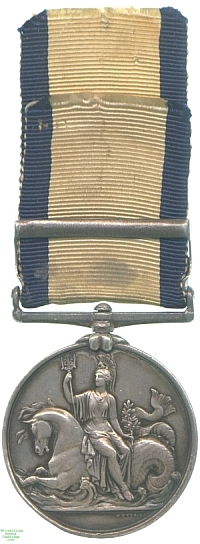
Obverse, a bust of Queen Victoria

Reverse, Britannia with a trident seated sideways on a seahorse

Obverse, a bust of Queen Victoria |

Reverse, Britannia with a trident seated sideways on a seahorse |
Just as in 1848 the extensive land campaigns of the Napoleonic Wars and the other conflicts of the pre-Victorian era were recognised by the issue of the Military General Service Medal, those serving in the Navy at the time were recognised with the Naval General Service Medal. As with the Army equivalent and the East India Company's related award, many of the battles for which the medal was awarded had been fought so long ago that few if any claimants survived.
In addition, bars were awarded for many actions whose significance and size were, despite the heroism displayed by those involved, relatively minor. The result was that many of the bars were issued in tiny numbers, with some combinations all but unique, and the medals command a very high price among collectors because of this rarity and individuality. This in turn, along with the manufacture in most cases of more bars than were eventually issued, has led to the `improvement' of many common awards where recipients' names are shared with those present at `rarer' battles. The medal also shares with the Military General Service and Army of India Medals the oddity that Queen Victoria, whose portrait they bear, was not the ruler under whom the battles for which it was awarded were fought.
HMS Redwing was a sloop under the command of Captain Thomas Usher, and in 1808 was involved in enforcing the blockade of the Spanish coast. On 7 May she encountered a Spanish gunboat off Cape Trafalgar, which she sank, and at the end of that month she captured two Spanish vessels under the guns of Tarifa, which she also put out of action. By the time of the award of the NGSM in 1848, only 8 and 5 people respectively were able to claim the bars awarded for these combats.
This medal is inscribed to Boatswain William Martin. Such a man did serve in Redwing at this time, and the Medals Roll confirms that he was among the few recipients for these bars. Several men of this name were however awarded more common bars like that for Syria. Redwing's Martin was also entitled to the bar for Copenhagen 1801, which this medal does not bear. Also, it was at some point mounted as a brooch (the marks are visible at each side) and then removed, which would help disguise other alterations. All these factors make it possible that this medal was originally to one of the other William Martins and retooled with the rare Redwing bars to increase its value. On the other hand, there are certainly cases of medals awarded without all the bars to which the recipient was entitled and other recipients whose medals were for a while mounted as brooches.
There is no final way to decide on the authenticity of this piece. Lester Watson purchased it from the dealer Gifford at some point before 1928; before that it had been sold at Glendining's in London in May 1915.